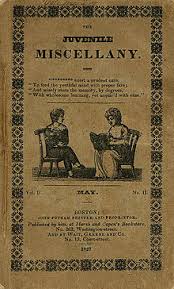America’s First Children’s Magazine
Listen to the Recess! Clip
| Author | Rita Smith |
| Air Date | 2/5/2003 |

America’s First Children’s Magazine Transcript
In 1826 Lydia Maria Child founded the Juvenile Miscellany which has been called the “first children’s magazine in America.” Child’s biographer, Carolyn Karcher, writes that Child “helped shape children’s literature into a powerful medium for socializing the young into the value systems adults wanted them to internalize [by using] the genre to inculcate the practice of the middle-class virtues of industry, frugality, temperance, self-denial, and perseverance as well as the principles she held most vital to a democratic republic…a commitment to equal rights for all and the courage to stand by one’s inner convictions. Yet the extent of that influence and the survival of the Juvenile Miscellany depended on Child’s remaining within bounds of the national ideology which she could not do.1 Her early contacts with American Indians who lived around her home in Maine had fostered a deep commitment to racial egalitarianism, and in the very first issue of the Miscellany there is a story which dramatizes a situation in which Indian and Anglo people live peaceably together. There are stories of other races as well: New Zealanders, Eskimos, Turks, and Chinese. These entertaining articles about foreign cultures did not antagonize her readership, and the public did not react negatively to Child’s message of racial equality until she applied it to African Americans.
From September 1830 on, nearly every issue of the Miscellany carried some reference to slavery – in a story, an article, an anecdote or a bit of information tucked away in an unlikely context – but she was careful not to offend her audience’s political and religious sensibilities through direct attacks on slavery. She once told a friend that she “attacked bigotry with a ‘troop of horse[s] shod with felt’; that is, I try to enter the wedge of general principles, letting inferences unfold themselves very gradually.”2 She accomplishes this, for example, by telling of a heroic act by a young boy, only revealing at the very end that the child is black. Another issue contains an article entitled “Some Talk About Cuba” where she discusses the island paradise as flawed by slavery.
Perhaps if Child had confined her radical egalitarian message to the medium of children’s literature, Juvenile Miscellany would have survived, but in 1833 she published Appeal in Favor of That Class of Americans Called Africans, an anti-slavery book which called for immediate emancipation and the integration of blacks as equal citizens. Parents canceled subscriptions to the Miscellany en masse, and shortly thereafter Child bid her young readers farwell. The magazine struggled along under another editor for two years before its final demise in 1836.
1 Karcher, p. 151.
2 Quoted by Karcher, p. 158.
Sources
Karcher, Carolyn L. The First Woman in the Republic: A Cultural Biography of Lydia Maria Child. Durham: Duke University Press. 1994.